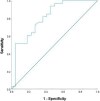Point of care ultrasonography of quadriceps femoris muscle thickness for assessing nutritional status in critically ill children
- PMID: 40374802
- PMCID: PMC12081691
- DOI: 10.1038/s41598-025-01205-w
Point of care ultrasonography of quadriceps femoris muscle thickness for assessing nutritional status in critically ill children
Abstract
Muscle wasting occurs early during critical illness. It is associated with poor PICU outcomes. Ultrasonography can detect muscle thickness in critically ill children. Study quadriceps muscle thickness to assess the nutritional status on admission and follow the muscle thickness change throughout the first week of admission in PICU using point-of-care ultrasonography. This cohort study was conducted on 55 critically ill mechanically ventilated children aged between 2 months and 14 years. Serial measurements of quadriceps muscle thickness were done by ultrasound, during the first week of admission. Quadriceps muscle thickness decreased by 16.4% over the 1st week of admission. The muscle wasting was significantly correlated with STRONGkids score, the inability to achieve target caloric requirements during the 1st week of admission, duration of ventilation, PRISM score, and mortality. Point of care ultrasonography is an easy tool for assessing PICU muscle wasting. Loss of muscle mass during the first week of PICU admission is correlated to mortality, thus it can be utilized in predicting PICU outcomes.
Keywords: Critically ill; Mortality; Quadriceps; Ultrasonography.
© 2025. The Author(s).
Conflict of interest statement
Declarations. Competing interests: The authors declare no competing interests.
Figures
Similar articles
-
Thigh Ultrasound Monitoring Identifies Decreases in Quadriceps Femoris Thickness as a Frequent Observation in Critically Ill Children.Pediatr Crit Care Med. 2017 Aug;18(8):e339-e347. doi: 10.1097/PCC.0000000000001235. Pediatr Crit Care Med. 2017. PMID: 28650903
-
Thigh ultrasound monitoring identifies muscle atrophy in mechanically ventilated pediatric patients.Eur J Pediatr. 2023 Dec;182(12):5543-5551. doi: 10.1007/s00431-023-05233-4. Epub 2023 Oct 2. Eur J Pediatr. 2023. PMID: 37782351
-
Assessing Clinical Variables Associated With Femoral Muscle Decay as Measured by Point-of-Care Ultrasound in Critically Ill Children.J Ultrasound Med. 2025 Jan;44(1):69-76. doi: 10.1002/jum.16579. Epub 2024 Sep 23. J Ultrasound Med. 2025. PMID: 39308358
-
Skeletal Muscle Ultrasonography in Nutrition and Functional Outcome Assessment of Critically Ill Children: Experience and Insights From Pediatric Disease and Adult Critical Care Studies [Formula: see text].JPEN J Parenter Enteral Nutr. 2017 Sep;41(7):1091-1099. doi: 10.1177/0148607116683143. Epub 2016 Dec 1. JPEN J Parenter Enteral Nutr. 2017. PMID: 29049016 Review.
-
Ultrasonography to measure quadriceps muscle in critically ill patients: A literature review of reported methodologies.Anaesth Intensive Care. 2019 Sep;47(5):423-434. doi: 10.1177/0310057X19875152. Epub 2019 Oct 22. Anaesth Intensive Care. 2019. PMID: 31640395 Review. No abstract available.
References
-
- Joosten, K. F. M., Kerklaan, D. & Verbruggen, S. C. A. T. Nutritional support and the role of the stress response in critically ill children. Curr. Opin. Clin. Nutr. Metab. Care19, 226–233. 10.1097/MCO.0000000000000268 (2016). - PubMed
-
- Sharma, K., Mogensen, K. M. & Robinson, M. K. Pathophysiology of critical illness and role of nutrition. Nutr. Clin. Pract.34, 12–22. 10.1002/NCP.10232 (2019). - PubMed
-
- Kawahara, K. et al. Evaluation of the site specificity of acute disuse muscle atrophy developed during a relatively short period in critically ill patients according to the activities of daily living level: A prospective observational study. Aust. Crit. Care30, 29–36. 10.1016/J.AUCC.2016.01.003 (2017). - PubMed
-
- Bury, C. et al. Use of bedside ultrasound to assess muscle changes in the critically ill surgical patient. J. Parenter. Enter. Nutr.45, 394–402. 10.1002/jpen.1840 (2021). - PubMed
MeSH terms
LinkOut - more resources
Full Text Sources



